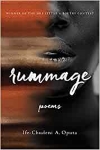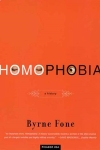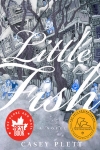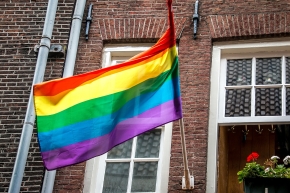It’s June and that means: It’s Pride Month! On this occasion, Litlog authors have compiled a colorful list of recommendations for you. Be they a bit older or current – you shouldn’t miss out on these five LGBTQ books, movies and series.
Ihr könnt diesen Artikel hier auf Deutsch lesen.
Trigger warning: Homophobia
And Then We DancedBy Sebastian Kipper
When it premiered at the 2019 Cannes Film Festival, the drama And Then We Danced received standing ovations for fifteen minutes. The screening in Germany, instead, was overshadowed by the Corona pandemic. This is regrettable as the Georgian-Swedish production is an enthralling contemporary contribution to the increasingly international queer cinema.
And Then We Danced portrays young dancer Merab (Levan Gelbakhiani) who has been training at the National Georgian Ensemble since his childhood. His dream is to become a successful dancer and travel the world. However, during class, Merab is often criticised by his dancing instructor as his style defies the ideal image of traditional Georgian dance. In addition, Merab is put under additional pressure by the arrival of the new dancing student Irakli (Bachi Valishvili), who turns out to be a talented dancer. At first, it looks like Merab and Irakli might become rivals after it was announced that a spot in the main ensemble has opened. But rivalry turns into desire to which both eventually succumb during a trip. With their love affair, however, both dancers put their potential careers at risk.
And Then We Danced portrays a society in which all gender and sexual identities deviating from the norm are sanctioned. The spot in the main ensemble became vacant because a male dancer was caught having sex with a man. For Merab, who wants to pursue a dancing career in order to escape his family’s poverty and the desolate economic situation of his country, his existence is at stake, should his homosexuality be revealed.
Film Info
Sweden/Georgia 2019
105 minutes
Director: Levan Akin
Starring: Levan Gelbakhiani, Bachi Valishvili, Ana Javakishvili and others
Even traditional Georgian dance is instrumentalised to perpetuate a regressive image of masculinity in Georgian culture and national identity. »The Georgian dance is based on masculinity«, his dancing instructor tells Merab. »There is no room for weakness in Georgian dance«. A sturdy posture with a straight back and chest pushed out, controlled movements – certain types of Georgian dance are meant to symbolise soldierly rigour and masculine strength, displayed to the beat of drums and the music of an accordion.
And Then We Danced portrays Merab’s artistic escape from this ingrained doctrine. Fuelled by his gay desire, he finds access to a new style of dancing outside the studio. Although Merab and Irakli do not seem to have words for their relationship, about which Georgian society is supposed to be quiet anyway, both find a common language via dancing. Similarly, Merab’s coming out takes place without any words. During his audition, Merab delivers an impressive performance by applying his newly discovered way of perceiving his body to the already familiar movements from the rehearsals. In essence, Merab queers Georgian dance moves.
However, the association of homosexuality with traditional Georgian dance was perceived as too much of a provocation by some people. In Georgia, the release of And Then We Danced was a target of mass rallies organised by far-right groups. The screening of the movie had to be protected by the police. The orthodox church also condemned the movie. In an interview, which is part of the DVD’s bonus material, director Levan Akin – who was born in Georgia but grew up in Sweden – says that homophobia persists as a norm in Georgian society because most Georgians do not know queer people who could refute the discriminatory images disseminated by ultra-conservative groups and the church.
Still, And Then We Danced is not a reckoning with Georgian culture but rather celebrates its dance and music, whilst critically exploring its gender conservative constraints. By recounting a gay love story between two young dancers, Akin succeeds in portraying a nation that clings to its national dance to affirm its own identity. He also exemplifies how Georgian dance could be renewed aesthetically once the rigid concept of masculinity is dissolved and fluidity is permitted.
Ife-Chudeni A. Oputa: RummageBy Hanna Sellheim
Somebody once said to me: »I like poems, but they don’t make any sense«. Ife-Chudeni A. Oputa’s Rummage is one of those collections that prove the opposite. In four sections, Oputa writes about childhood and coming-of-age (We Are Sitting Around Discussing Our Shame), then about a break-up (A Brief History of She), about the human body (Lessons on the Body) and about weltschmerz (All the Dead Call You Friend). Oputa was a fellow of the US-American literary collective Lambda Literary, which does not only award prizes to LGBTQ authors, but also gives out scholarships and holds writing workshops.
Yet, (as often the case) one would be mistaken to read Rummage merely in regards to its queer topics. There is much more in the slim book; from experiences with racism (Tunnels) to the depths of a sister relationship (Mosaic in Nine Lives) and reflections on evolution (Portrait of Memory with Evolution). A recurring theme is shame, which Oputa introduces in the first poem Ode to Shame with the well-chosen symbol of the ash tree, eponym for her hometown Fresno (Spanish for ash tree) in California.
Oputa manages to put the sadness after a break-up, the loneliness and pain, acutely into words. In an impressively beautiful manner, she writes about longing and change. Especially compelling is her exploration of the metaphoric field of prism/kaleidoscope/microscope in combination with the typography in Transition:
* * * * *
A single ray of light passes through a prism’s blade
and it is a million rays of light. It is a billion molecules
of no. A trillion atoms of stay–
and then it is not.
*
The tripartition of the poems structures this process of change, which ends in a dialectical solution: »Everything looks alien / when seen through another lense– […] Pull the eye back from the glass, / blink let it come into focus«
At the same time, hope blooms in Oputa’s verse: In the last poem, the recurring motif of silence, of a missing answer, is finally answered by a choir, the poem Girls as Matryoshka Dolls; or, a Brief History of She, which stands out due to its length, ends with the promise of a »new myth all your own« and in On the Early Arrival of Spring the speaker, who is dressed way too warm for the first spring day, encounters a stranger in patterned tights who makes her forget an ex-girlfriend and augurs a new beginning: »Made me remember // how good the glint of the strange can be // when you stumble / toward it. When you look on // without stopping–«
Hence, the book can be read not only as a collection of single poems, but also as a whole, as a process of self-discovery in which the speaker learns to situate queerness as part of her identity, overcoming the shame imposed from the outside. So much about poems making sense.
Byrne Fone: Homophobia. A HistoryBy Philip Flacke
»The COVID-19 pandemic has led to even higher levels of violence and discrimination against LGBTI persons«. Thus reads the unambiguous official declaration of the EU on occasion of this year’s IDAHOT (International Day Against Homophobia, Transphobia and Biphobia). The effects the pandemic has on queer persons differ depending on country, additional experiences of discrimination and other circumstances. Sometimes they are very severe, including in Germany.
Meanwhile, some religious authorities can think of nothing wiser than to put the blame for the virus on the LGBTQ community. During the first wave in Turkey, Ali Erbaş, President of Religious Affairs, proclaimed that homosexuality and unmarried partners were causes of illness – a statement that president Erdoğan defended as »correct in every way«. The Ukrainian Patriarch Filaret called the virus a punishment for the sins of humankind, especially same-sex marriage. Others could be added to this list. Men like Filaret and Erbaş are the exception, in their religious communities and on the whole, but an exception with high standing and influence.
Talk of epidemic queerness is particularly painful since HIV/AIDS, but this manner of speaking has been around roughly as long as the construction of the Sodom-story as the homophobic ur-myth. The scholar Philo of Alexandria, who lived around the year zero, imagined life in Sodom in bright colours: Same-sex desire appears as an illness to him. It degenerates the body, is transmitted from one to the other and spreads like an epidemic disease.
How extraordinarily consistent stereotypical metaphors and assertions persist throughout several millennia of homophobia! This persistence can be studied in Homophobia, A History – a book by American literary scholar Byrne Fone. Trigger warning: Fone also talks about abuse allegations on multiple occasions. The book is not new – it was published twenty years ago. While there is a Spanish translation, in Germany the book seems to have been barely noticed. Thus the union catalogue GVK lists only a single copy, in the State and University Library Hamburg. Hopefully, a copy will be added in Göttingen soon.
Fone provides an overview from Greek antiquity up to the twentieth century. Strictly speaking, the term ›homophobia‹ is too narrow for Fone’s subject-matter. He examines the various forms of rejection, discrimination and persecution of people who love or desire someone of their own gender and of those who do not fulfil the gendered expectations assigned to them. This wide scope makes sense. But readers today would like to ask more sensitivity from Fone not to give the impression that trans women who love men could perhaps be subsumed under male homosexuals.
Fone is aware of the importance of intersectionality when it comes to mechanisms of discrimination: »Homophobia has links with sexism as well as with anti-Semitism and with prejudice against people of color«. Discourse about women features far less prominently than discourse about men. Colonial history, which has all too often also meant exporting a homophobic worldview and homophobic laws, is discussed almost only with regard to North America. The deportation of homosexuals in Nazi-Germany surprisingly does not feature at all. Despite these omissions: Fone overviews a vast period, and he provides detailed insight into documents of various countries and languages in Western Europe, the Mediterranean region and the US.
Homo-, bi- and transphobia aren’t just there and that’s that – they have a history. Fone tells a story not just of hate, disgust and fear but also of overcoming these and of fighting for rights and recognition. His book has two important strengths. For one thing, he compiles what numerous other scholars in the field have unearthed. For another thing, he stays close to the historical sources and provides ample readings of legal texts, treatises, reports, poems, novels and other most interesting material. His prose is easy to understand, and his chapters are so well structured that any one of them can be read out of context if needed. What their entirety reveals is not a linear development of progress but again and again the terrible simultaneity of tolerance and ignorance, the up and down of achieving and losing again, and the willingness to fight one form of discrimination by promoting another. In the time of the pandemic and climate change one insight is especially terrifying: How radical change and collective traumatic experiences can jeopardise tolerance of sexual minorities. Therefore as well, we need a queer historical consciousness.
Tales of the CityBy Lisa M. Müller
Göttingen is a textbook example of a certain feeling ranging from »ah, that’s right, I’ve seen that person in the ›Turmmensa‹ several time« to »we took the same French course with Madame Bréhinier in the second semester, AND we both like the falafel at ›Grüner Libanon‹ – that can’t be a coincidence«. One of my favorite series, which I would like to recommend warmly here, reminds me of this feeling: the series Tales of the City, based on Armistead Maupin’s novel series of the same name. Both season 1 from the 1990s and the revival from 2019 are available on Netflix.
Series Info
USA 1993/2019
Idea: Richard Kramer/Lauren Morelli
Starring: Laura Linney, Elliot Page, Olympia Dukakis and others
The series deals with important topics of the 90s as well as our time: HIV and dying of AIDS as well as struggles for recognition and equality of queer life. All of this is told in a natural and appropriate way. The characters become a family, but the observer also feels very close to them. The narrative pace of the old episodes is pleasantly slow and the style is warm in all seasons.
Some cross/queer connections in the series may seem a bit deliberate, but reality is often just as interconnected, especially for queer people. In Göttingen, new acquaintances often already have (ex) partners, fellow students or party flirts in common. These coincidences multiply for queer people in Göttingen. That is partly the case because there are only a few places for queer life. In turn, the few queer-positive places in Göttingen, such as the collectively run Café Kabale, are very nice and important. Hopefully, we will soon be able to sip a lemonade there with a good feeling about it and minor corona worries. Until then, check out Tales of the City!
Casey Plett: Little FishVon Linus Lanfermann-Baumann
Have you ever spent an entire winter in Winnipeg, Canada? Or immersed yourself in Russian Mennonite culture in southern Manitoba? Perhaps several middle-aged trans women are among your friends? Or you happen to be familiar with the day-to-day business of sex work? If not, then Casey Plett’s novel Little Fish is a wonderful chance to explore these uncharted waters.
Plett, a Canadian, Mennonite trans woman herself, tries to write what she calls »truthful« stories about these worlds. Visiting McMaster University in March 2021, she said she was well-aware that most readers would not be familiar with them. And of those who are, she added with a smile, »half of them are probably my friends«. Still, she invites her readers to immerse themselves into her story, to dwell with the unfamiliar:
Maybe you don’t understand every nuance about what these things are, but hopefully you understand how the characters are feeling about them and what that means in the immediate moment.
Little Fish is at times as disturbing as it is hopeful overall. Suicide, sexual violence, and alcoholism are intertwined with experiences of goodness, friendship, and love in many varieties. While it is unfortunate that Plett’s work has not yet been translated into German, Little Fish is not overly ornate. Anyone with intermediate English skills (and for whom the often-unsettling topics are no deal-breaker) can gain brutally honest insights into worlds yet unacquainted with. Just take Plett up on her invitation and see where it leads you.


















